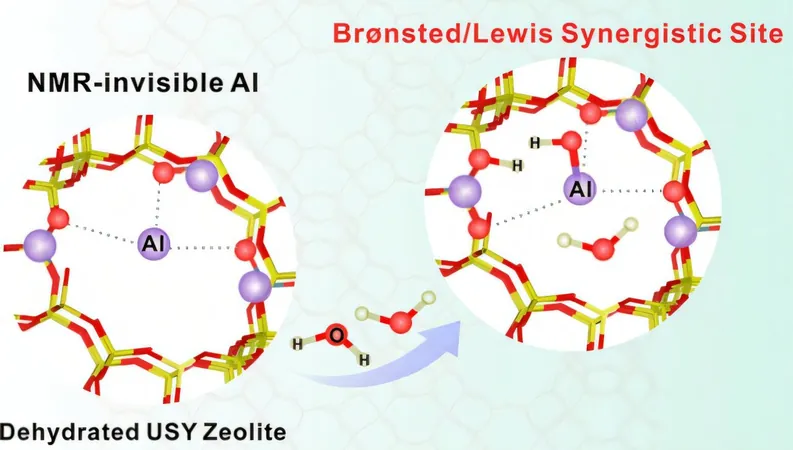
Unveiling the Hidden Power: Water Turns Invisible Aluminum into Catalytic Superstars
2025-07-03
Author: Wei Ling
A Groundbreaking Discovery in Catalysis
In a stunning breakthrough, researchers from the Innovation Academy for Precision Measurement Science and Technology (APM) at the Chinese Academy of Sciences have revealed that water can awaken previously hidden aluminum sites in ultra-stable Y (USY) zeolite. This revelation is set to revolutionize catalysis, a field critical for various industrial processes.
The Magic of Zeolites in the Chemical World
Zeolites are more than just microporous materials; they are the backbone of the petrochemical and fine chemical industries, prized for their adjustable acidity and remarkable stability. These properties make them crucial for transforming raw materials into valuable chemicals.
Water: The Unsung Hero of Catalysis
Water, often overlooked in catalytic reactions, plays a multifaceted role as a solvent, reactant, product, and catalyst accelerator. Its influence on zeolite acidity and reaction dynamics can be profound, but understanding the specifics has long been a puzzle.
Unlocking the Enigma of 'NMR-Invisible' Aluminum
The research team tackled the mystery surrounding key Lewis acid sites (LAS), particularly the tri-coordinated and extra-framework aluminum species that were previously "NMR-invisible." Their invisibility has obscured their catalytic potential for far too long.
A Deep Dive into Dynamic Interactions
Employing cutting-edge solid-state NMR techniques alongside theoretical calculations, the researchers conducted an exhaustive investigation into the dynamic relationship between these elusive aluminum species and water within dehydrated USY zeolites. What they found was groundbreaking.
A Catalytic Power Boost: The Water Effect
The findings revealed that water, via dissociative adsorption, drastically increases Brønsted acid sites (BAS) by over 60%. This transformation creates synergistic acid sites that significantly boost the catalyst's efficiency for converting diethyl ether into ethylene, a key reaction in producing plastics and other chemicals.
Cutting-Edge Techniques Illuminate Hidden Chemistry
Using 27Al MAS NMR experiments, the research team traced the evolution of aluminum species, turning "NMR-invisible" sites into detectable forms that generate BAS across various aluminum coordination states. They also employed sophisticated 1H–1H DQ–SQ NMR techniques to examine the spatial relationships among hydrogen species in the USY samples, revealing how water changes the catalytic landscape.
Implications for the Future of Catalysis
This groundbreaking research not only enhances our understanding of zeolite catalysts but also opens new avenues for optimizing catalytic processes across industries. The potential to harness water’s transformative effects on zeolitic materials could lead to more efficient, sustainable chemical production methods.




 Brasil (PT)
Brasil (PT)
 Canada (EN)
Canada (EN)
 Chile (ES)
Chile (ES)
 Česko (CS)
Česko (CS)
 대한민국 (KO)
대한민국 (KO)
 España (ES)
España (ES)
 France (FR)
France (FR)
 Hong Kong (EN)
Hong Kong (EN)
 Italia (IT)
Italia (IT)
 日本 (JA)
日本 (JA)
 Magyarország (HU)
Magyarország (HU)
 Norge (NO)
Norge (NO)
 Polska (PL)
Polska (PL)
 Schweiz (DE)
Schweiz (DE)
 Singapore (EN)
Singapore (EN)
 Sverige (SV)
Sverige (SV)
 Suomi (FI)
Suomi (FI)
 Türkiye (TR)
Türkiye (TR)
 الإمارات العربية المتحدة (AR)
الإمارات العربية المتحدة (AR)